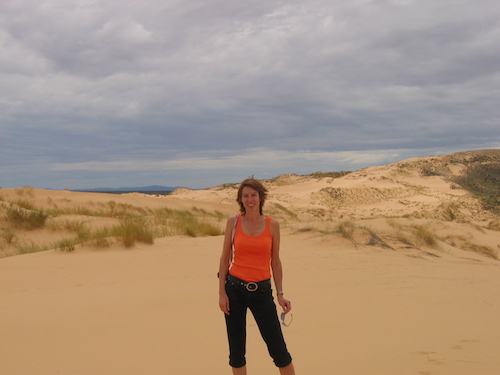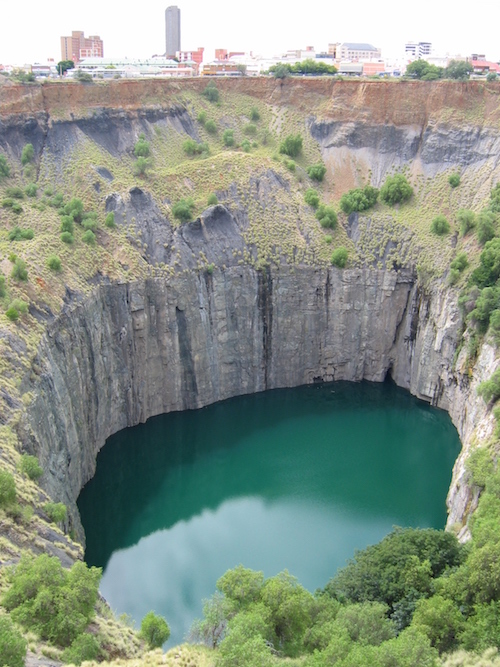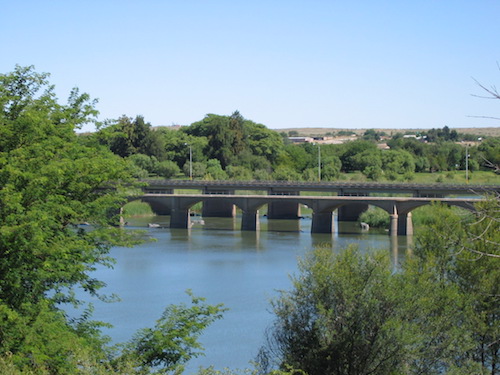 It must have been 2am when my bikini finally blew away.
It must have been 2am when my bikini finally blew away.
It had been a heroic battle, but the flimsy straps were no match for a ferocious wind whipping through Khamkirri campsite in the bleak Northern Cape. Luckily I wasn’t wearing it at the time. I’d tied it to the guy ropes to dry after white water rafting down the Orange River.
If you’re not the sort who can tolerate your clothes blowing away, you’re not built for the Northern Cape. It’s a wild place, perfect for robust types who think it’s huge fun to spend all day driving through kilometres of nothing to reach absolutely nowhere. The province covers almost a third of South Africa but has fewer than 1-million inhabitants, or two people for every square kilometre.
Most people dismiss it as a desolate sandpit, and it will never be the country’s tourism hotspot. Although it’s certainly hot, with temperatures cracking a blistering 40°C in summer.
 So what can you expect from a place whose capital is famous for a big hole? The Big Hole at Kimberley is the largest man-made excavation in the world, hewn in the diamond rush of 1871. Now it’s the centrepiece of the diamond museum and a recreated mining town where excellent guides bring history to life.
So what can you expect from a place whose capital is famous for a big hole? The Big Hole at Kimberley is the largest man-made excavation in the world, hewn in the diamond rush of 1871. Now it’s the centrepiece of the diamond museum and a recreated mining town where excellent guides bring history to life.
Just outside Kimberley is Kamfers Dam, a flamingo breeding ground with anything from 39,000 to 59,000 birds that never stand still long enough to be counted. Together they make a gentle starting point before you tackle the more remote Kalahari and Green Kalahari, Namakwa and the Karoo.
A few hours out of Kimberley we stopped at Witsand, an unusual nature reserve of beach sand despite being nowhere near the coast. I climbed a muscle-stretching dune 60m high, realising this is a very strange land indeed. An even more astonishing sight was a little shack that stands in absolute isolation in Mokala National Park. There are paraffin lamps, solar-heated water and basic gas cooking equipment, but nothing else except thorn trees and vast skies. Yet the shack is continually booked by exhausted city slickers seeking utter solitude, which the Northern Cape has in abundance.
Khamkirri camp where I stayed is far better equipped, and lies on the bank of the Orange River in the Green Kalahari. I spent the afternoon tackling four minor rapids in two-man dinghies that quickly resembled giant dodgem cars as amateur adventurers buffeted for space.
Khamkirri also offers mountain bikes, quad bikes, horse riding, abseiling and kayaking, with hot showers and a tasty buffet waiting to revive you. As you bed down at night the Milky Way is spectacular, reaffirming that there’s only a tent flap between you and nature.
The nearby Augrabies Falls are the sixth largest waterfalls in the world, but I stuffed up and arrived in dry season. Relentless sun had turned the mighty Orange River into a skinny trickle through the 56m deep chasm. The sheer granite walls are stunning, and sturdy walkways looking down over the most scenic stretches must be fabulous when the river is in full flow.
There’s water of a different sort at Riemvasmaak, with hot springs reached after a long drive up dirt tracks. The springs flow into an ugly concrete pool, but steps lead down to a far prettier natural rock pool where I teased tadpoles that retaliated by nipping my legs.
 Riemvasmaak is understandably difficult to reach, with an Afrikaner friend promising me its name loosely translates as ‘apply the brakes.’ We applied the brakes a lot as we drove through massive granite cliffs dwarfing the vast desert wilderness below.
Riemvasmaak is understandably difficult to reach, with an Afrikaner friend promising me its name loosely translates as ‘apply the brakes.’ We applied the brakes a lot as we drove through massive granite cliffs dwarfing the vast desert wilderness below.
Some of the best 4x4 trails include the Kalahari Red Dune Route heading towards Kgalagadi Transfrontier Park, one of the largest conservation areas in the world. Kgalagadi is studded with red sand dunes and sparse vegetation that supports herds of antelope, gemsbok and eland as well as black-maned Kalahari lions, leopard and cheetah.
Witsand Nature Reserve has a 36km drive through the Kalahari dunes, and for a closer feel of just how hard soft-looking sand can be, hire a dune board to come down far faster than you went up. For more of that wind-in-your-face feel ditch the comfy 4x4 completely and try adventure motorcycling, with tour companies designing trails that blend stark scenery with history and adventure.
Hiking trails are popular too, although some close from October to March when the heat takes adventure into the altogether more dangerous realm of suicidal. The 3-in-1 Adventure in Augrabies Falls National Park has you canoeing in the gorge, hiking back out of it, then mountain biking back to the camp. Accommodation is in self-catering chalets, but if you’re too exhausted to cook you can recuperate in the restaurant.
The heat rising from the baking ground creates thermals that are perfect for paragliders, and many world records have been set around De Aar with flights of 350km recorded. After a few days of rough and tumble you might be ready for some relaxing fly fishing, with the lower Vaal and Riet Rivers at Kimberley billed as world class sites for yellowfish.
 Tourism is apparently on the rise in the Northern Cape and is one of the biggest contributors to its economy – although cynics would say that’s because there is almost nothing else to contribute any income.
Tourism is apparently on the rise in the Northern Cape and is one of the biggest contributors to its economy – although cynics would say that’s because there is almost nothing else to contribute any income.
Sleepy Upington is so quiet on a Sunday that not even the robots are working. A leaflet helpfully lists the town’s attractions as a statue of a donkey and an avenue of date palms. That makes Upington’s greatest attraction a cruise on a river boat with the ergonomics of a floating tea-chest. The captain entertains himself by turning pirouettes under a bridge, while passengers get drunk with bar prices that are music to a tourist’s ears. They inevitably end up dancing, and at this stage you can tell true admirers of the Northern Cape from those just here by accident. A real adventurer would take one look at the impromptu boat party and move on to avoid the crowds.